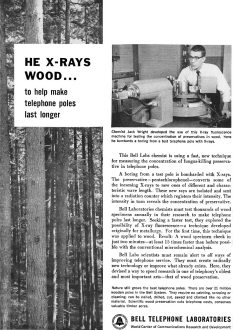Bell Telephone Laboratories |
|||||
Is that an early tin foil hat prototype the lady on the cover of this month's Radio−Electronics magazine is modeling? Tin foil hats for RF radiation conspiracy kooks were probably not even a thing back in 1960. In some ways it fits in with the x−ray subject of the Bell Telephone Laboratories infomercial in the same issue. As you can see from the large and ever-growing list of Bell Labs promotions at the bottom of the page, the world's premier telephone company didn't get to the top by luck. Bell engineers and scientists were continually conducting research and development to assure service would be as efficient, affordable, and reliable as possible. Bell Telephone Laboratories was at the leading edge of communications technology, both wired and wireless, since day its founder uttered the words, "Mr. Watson, come here... I want to see you." Bell Telephone Laboratories - He X-Rays Wood ...
Chemist Jack Wright developed the use of this X-ray fluorescence machine for testing the concentration of preservatives in wood. Here he bombards a boring from a test telephone pole with X-rays. This Bell Labs chemist is using a fast, new technique for measuring the concentration of fungus-killing preservative in telephone poles. A boring from a test pole is bombarded with X-rays. The preservative - pentachlorophenol - converts some of the incoming X-rays to new ones of different and characteristic wave length. These new rays are isolated and sent into a radiation counter which registers their intensity. The intensity in turn reveals the concentration of preservative. Bell Laboratories chemists must test thousands of wood specimens annually in their research to make telephone poles last longer. Seeking a faster test, they explored the possibility of X-ray fluorescence - a technique developed originally for metallurgy. For the first time, this technique was applied to wood. Result: A wood specimen check in just two minutes-at least 15 times faster than before possible with the conventional microchemical analysis. Bell Labs scientists must remain alert to all ways of improving telephone service. They must create radically new technology or improve what already exists. Here, they devised a way to speed research in one of telephony's oldest and most important arts - that of wood preservation. Nature still grows the best telephone poles. There are over 21 million wooden poles in the Bell System. They require no painting, scraping or cleaning; can be nailed, drilled, cut, sawed and climbed like no other material. Scientific wood preservation cuts telephone costs, conserves valuable timber acres. Bell Telephone Laboratories World Center of Communications Research and Development
Posted January 27, 2023
|
|||||

